You've got to believe that it's magic
The top craze in the late Thirties and during World War II
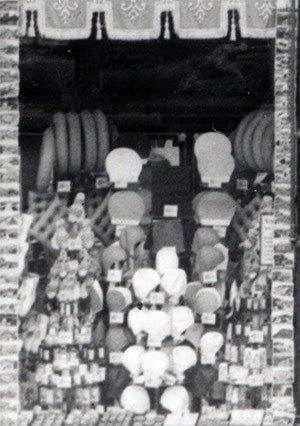
As its toy department grew in popularity between the World Wars, Woolworth built a strong following for its range of simple toys. It stocked everything from marbles and rubber balls to cricket bats and tennis rackets. Other favourites included soft toys and dolls, jigsaws and puzzles. Remarkably not a single item cost more than sixpence (2½p at the time, £2.11 today), and there were plenty of things for a single old penny (equivalent to roughly 35p in 2023).
The items were cleverly designed and simply made. But few caught the public's imagination like its practical jokes and magic tricks of the late 30s. It all began when Ellisdon & Son took Woolworth's up on its open door policy, sending a representative to New Bond Street to meet the Toy Buyer, Clifford Prescott. The representative acknowledged his efforts with 'not very magic lines' from 'others' but suggested now he try the best. Ellisdon was the magic supplier, down under, across the Empire and of course in the UK. They sold by mail order direct to Magicians, by wholesale to retailers and had a few shops in London near their headquarters in High Holborn, also selling through their neighbours, the world-renowned Gamages Department Store and its legendary catalogue.
Prescott, a famously hen-pecked American, quickly accepted Ellisdons' initial offer of surplus items, some of which would sell for threepence and others for sixpence, which he noted was under half the price at the Ellisdons' a couple of doors from Woolworth's at 8-13 High Holborn.
Those items sold quickly prompting a number of further orders, initially for further surplus production, until Ellisdons accepted Prescott's challenge to rework a small selection of their perennial sellers into cheaper variants to fit the Woolworth price policy and become a 'staple range' to be stocked all year round. To keep the supplier's costs low, two special measures were agreed. Firstly the packaging could be plain and simple, just a stapled lightweight greaseproof bag, and secondly Woolworth would carry the distribution cost, collecting the goods from a factory near central London and distributing them by train through its Granary Warehouse at the nearby LMS St Pancras Goods Station (below).

Despite mutterings from a few stores that they would have to be careful that "little oiks" didn't perform their own conjuring tricks in slipping the small packets up their cuffs while supposedly examining them on the counter to avoid paying for them, the overwhelming feedback was positive, with lots of S59 Sales Reports requesting similar lines. Ordinarily this would have been the cue for organic growth, adding a few extra lines each season. But everything changed when the world went to war.
Between Autumn 1939 and Spring 1940 many factories switched to war production, with others centrally-directed to switch to delivering 'essentials'. It seemed Woolworth might have to withdraw its toys, playing cards and comic books altogether until the Company Chairman intervened. He had been co-opted to a Government role as Head of Aircraft Production for the Air Ministry, bringing the Company's legendary mass-production techniques to the RAF's urgent need for Spitfires. His boss was the Canadian Press Baron Lord Beaverbrook. The two men were like chalk and cheese but found one area of common ground. Both were worried about morale as plans were laid for families and children to spend nights in home-built Anderson Shelters or new public sleeping facilities like those set up on the deeper platforms of the London Underground.
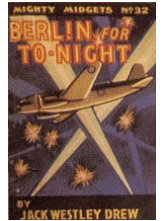 Stephenson persuaded Beaverbrook to supply paper and card at subsidised prices from his publishing empire to allow Woolworth to market morale boosting ranges for children and their families. With the deal agreed in principle, the supremo set his Buyers back at Woolworth to work, requesting product nominations, which must be offered for no more than sixpence. Among the successful suggestions were tiny comic-like story books called Mighty Midgets (which are shown in the Stationery Gallery of the Woolworths Museum), jigsaws from Lumar (here in the Toys Gallery) and Magic. The Buyer reported that Ellisdons would probably be receptive to an approach as they had been threatened with being forced to switch to producing essentials like military passes and ration books by a Man from the Ministry.
Stephenson persuaded Beaverbrook to supply paper and card at subsidised prices from his publishing empire to allow Woolworth to market morale boosting ranges for children and their families. With the deal agreed in principle, the supremo set his Buyers back at Woolworth to work, requesting product nominations, which must be offered for no more than sixpence. Among the successful suggestions were tiny comic-like story books called Mighty Midgets (which are shown in the Stationery Gallery of the Woolworths Museum), jigsaws from Lumar (here in the Toys Gallery) and Magic. The Buyer reported that Ellisdons would probably be receptive to an approach as they had been threatened with being forced to switch to producing essentials like military passes and ration books by a Man from the Ministry.
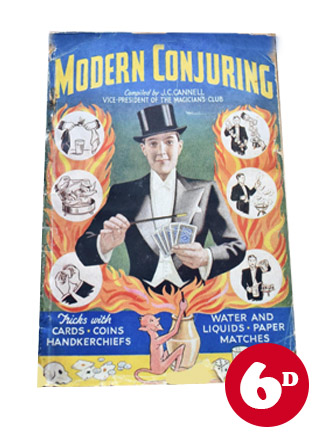
As predicted. Ellisdon and Son quickly rose to the challenge. Within weeks they had reworked some of their existing items to fit in with the materials that Beaverbrook could make available, and had collated them into a four page brochure. The lines would be in plain packaging, with no mention of the Ellisdon & Son brand, other than a tiny "E & S" in the footer of the leaflet. To meet the volumes required they also acquired temporary new premises in Central London, and agreed terms with Beaverbrook for additional supplies of paper, card and other materials to allow them to fulfil orders for their other customers without an upper price limit, arguing that these would be needed to subsidise the Woolworth Morale Boosters.
As you will see from the leaflet below, despite the World War, Ellisdons had managed to create a remarkable range of tricks and practical jokes, holding every price to just sixpence (2½p or 10¢, or around £2.11 or $1.80 today). There was even a selection for threepence, just half that amount.
To put the word out, Ellisdon & Sons, placed adverts in the national press, and had leaflets printed to hand out in-store, as well as including one in each product's pack. The simple brochures were the easiest way to show off their lines and explain what they did. We have one of those four pagers from around 1940, which you can see below, or,if you prefer, you can download and print a PDF version Some of the tricks look old and quaint today, but many would still be as impressive in the 21st century as they were at distracting our great grandparents from the air raid sirens and the sound of the Luftwaffe overhead over eighty years ago.
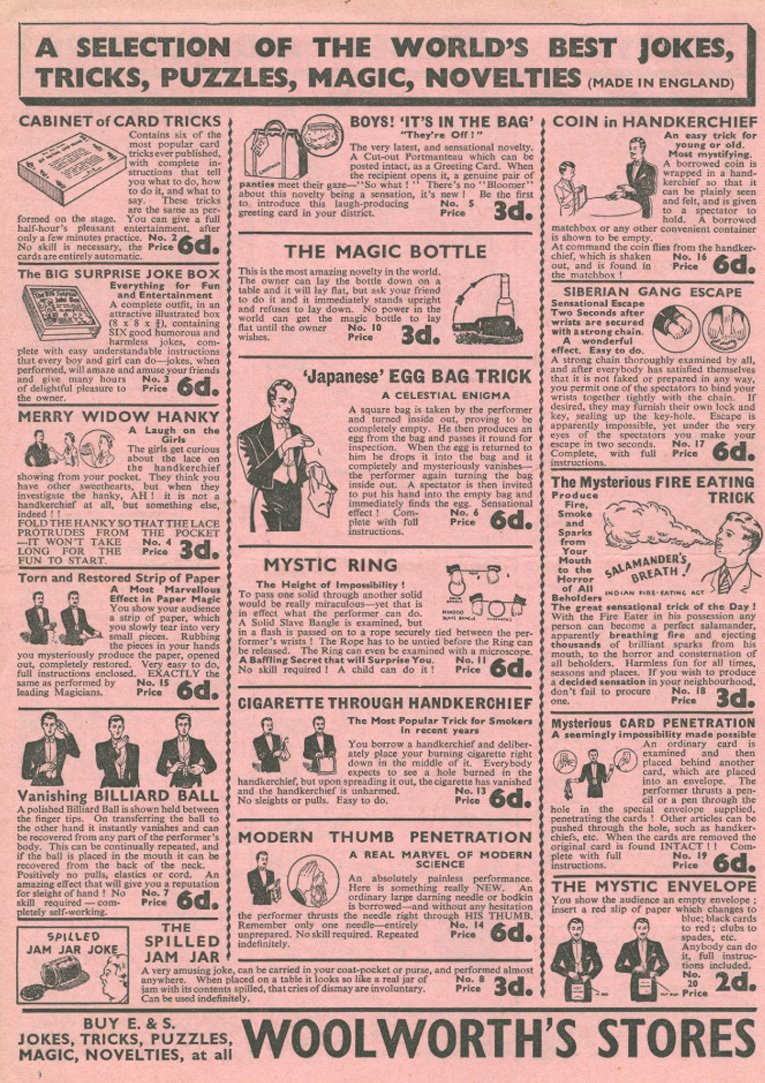
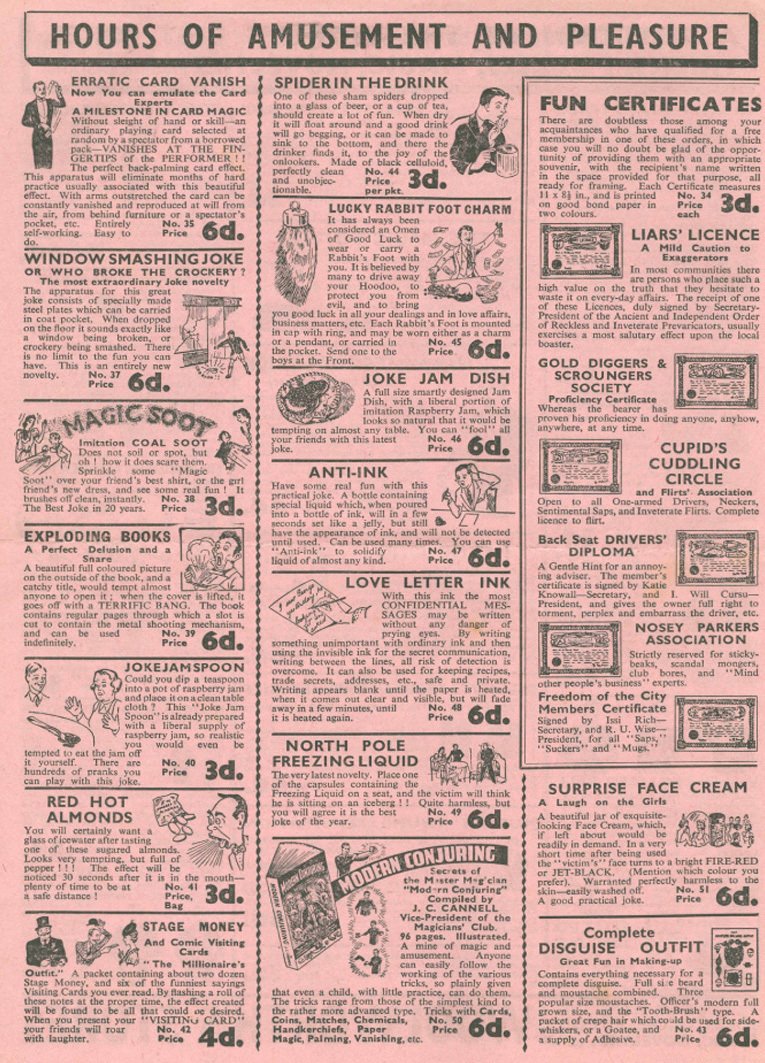
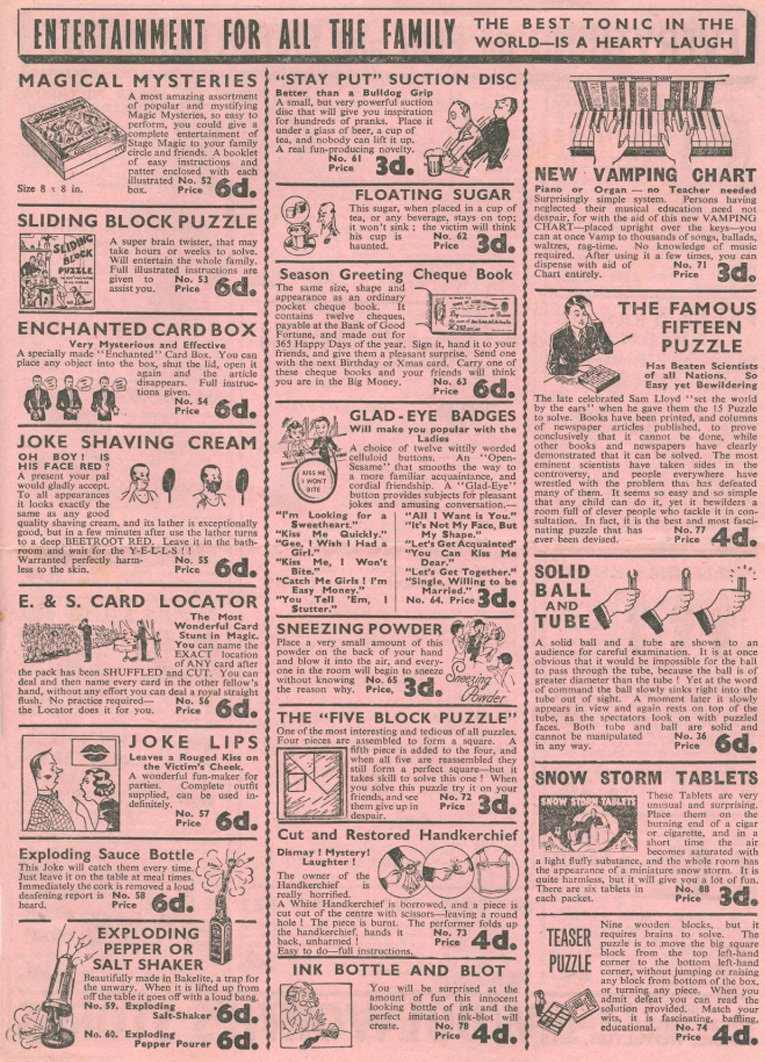
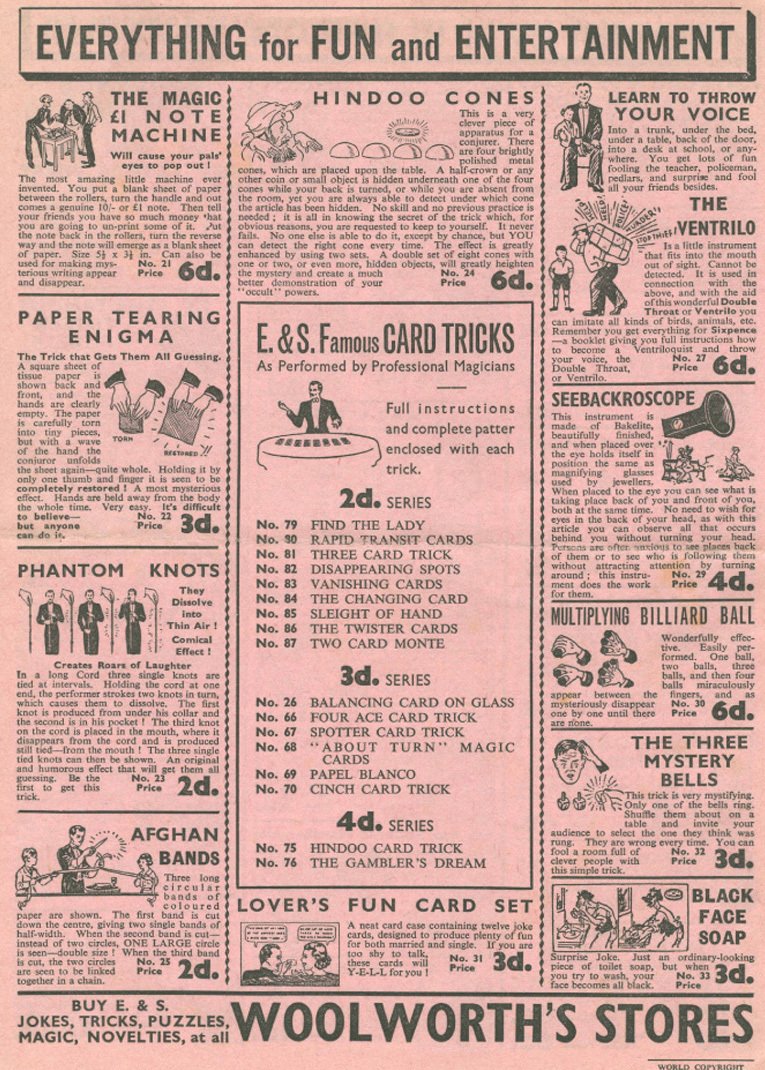
The enlarged Magic range was a winner from the start. Stephenson and Beaverbrook had been right in believing that children love magic and that it would prove the perfect distraction from enemy action overhead. Ellisdons had also excelled, proving themselves both imaginative and adaptable - equally able to design products for the ruling classes to be sold from Gamages and its catalogue, or the clientele at Woolworths, and able to establish their own mass-manufacturing capabilities to take up the slack when it was no longer possible to import from third-party factories overseas. You can read much more of the supplier's story, and celebrate their contribution to the world of magic in Philip David Treece's superb two-volume history of Ellisdons, which was invaluable in preparing this page of the Woolworths Museum. We are very grateful for his help and advice. The books are available exclusively from Collecting Magic Books (CMB) in Sheffield. Click the link to find out more about Philip David Treece's 'Ellisdons, the History, Volumes 1 and 2' .
Shortcuts to related content
Wonders from Woolies
Bonus Items - The History of Chad Valley
Now owned by Argos / J. Sainsbury plc, Chad Valley was revived and developed by Woolworths over a 21 year period
Toys for Toffs, the early ranges
TV changes everything in the 1950s and 1960s